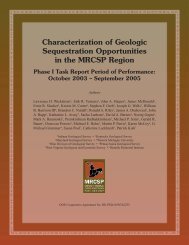Unraveling the stratigraphy of the Oriskany Sandstone: A necessity ...
Unraveling the stratigraphy of the Oriskany Sandstone: A necessity ...
Unraveling the stratigraphy of the Oriskany Sandstone: A necessity ...
You also want an ePaper? Increase the reach of your titles
YUMPU automatically turns print PDFs into web optimized ePapers that Google loves.
evaluating <strong>the</strong> sequestration potential <strong>of</strong> a given injection<br />
site based on <strong>the</strong> variability observed in <strong>the</strong> <strong>Oriskany</strong><br />
structure, lithology, and reservoir characteristics.<br />
INTRODUCTION AND PURPOSE<br />
Four types <strong>of</strong> geologic reservoirs have <strong>the</strong> potential to<br />
sequester carbon dioxide (CO 2): deep saline formations,<br />
depleted oil and gas fields, carbonaceous shales,<br />
and unmineable coals. Wickstrom et al. (2005) identified<br />
<strong>the</strong> Lower Devonian <strong>Oriskany</strong> <strong>Sandstone</strong> as one<br />
<strong>of</strong> several potential deep-saline formations capable <strong>of</strong><br />
sequestering carbon in <strong>the</strong> Appalachian Basin. Factors<br />
used in evaluating deep-saline units for CO2 injection<br />
potential include depth, porosity, permeability, injectivity,<br />
reservoir pressure, and water chemistry. In addition<br />
to <strong>the</strong>se physical reservoir characteristics, evaluating <strong>the</strong><br />
reservoir seals (overlying, underlying, and lateral) that<br />
will prevent postinjection migration <strong>of</strong> CO2 is also necessary<br />
(Wickstrom et al., 2005).<br />
The estimated volumetric storage capacity <strong>of</strong> CO 2<br />
in <strong>the</strong> <strong>Oriskany</strong> <strong>Sandstone</strong> is 194.3 gigatonnes (1.912<br />
10 11 tons) (Midwest Regional Carbon Sequestration<br />
Partnership [MRCSP], phase I study; Wickstrom et al.,<br />
2005). The volumetric storage capacity measures <strong>the</strong><br />
amount <strong>of</strong> CO2 that can be retained in <strong>the</strong> pore space<br />
<strong>of</strong> a particular formation and in saline formations assumes<br />
that brine is completely replaced with CO 2.The<br />
calculation essentially estimates <strong>the</strong> total pore volume<br />
based on reservoir geometry and porosity. Carbon dioxide<br />
density, temperature, and pressure are also factored<br />
into <strong>the</strong> equation. Based on <strong>the</strong>se assumptions and previously<br />
published data (no detailed porosity studies were<br />
conducted by <strong>the</strong> MRCSP during <strong>the</strong> phase I study), <strong>the</strong><br />
<strong>Oriskany</strong> is a viable target for carbon sequestration, but<br />
local variations in lithology and structure make more<br />
detailed studies necessary prior to injection into <strong>the</strong><br />
<strong>Oriskany</strong> <strong>Sandstone</strong>. The purpose <strong>of</strong> this article is to<br />
examine site-specific <strong>Oriskany</strong> reservoir data to determine<br />
how geographic and stratigraphic variations influence<br />
<strong>the</strong> sequestration potential <strong>of</strong> this particular unit<br />
and to recommend <strong>the</strong> most likely sites for <strong>the</strong> successful<br />
sequestration <strong>of</strong> CO2 in <strong>the</strong> <strong>Oriskany</strong> <strong>Sandstone</strong>.<br />
ORISKANY SANDSTONE<br />
The <strong>Oriskany</strong> is Devonian in age. It is overlain by different<br />
rocks within <strong>the</strong> North American Onesquethawan<br />
188 Sequestration Potential <strong>of</strong> <strong>the</strong> <strong>Oriskany</strong> <strong>Sandstone</strong><br />
stage and varies in lithology from limestone to chert to<br />
shale moving from west to east across <strong>the</strong> basin (Basan<br />
et al., 1980). Basal sand units <strong>of</strong> <strong>the</strong> Onondaga Limestone<br />
and Bois Blanc Formationmaydirectlyoverly<br />
<strong>the</strong> <strong>Oriskany</strong>, and distinguishing <strong>the</strong> contact between<br />
<strong>the</strong> two may be difficult (Diecchio, 1985). These overlying<br />
units include <strong>the</strong> Bois Blanc Formation in Ohio<br />
and northwestern Ohio, <strong>the</strong> Onondaga Limestone in<br />
West Virginia, <strong>the</strong> Huntersville Chert in central and<br />
southwestern Pennsylvania, and <strong>the</strong> Needmore Shale<br />
in south-central Pennsylvania and Maryland (Basan<br />
et al., 1980) (Figure 1).<br />
The <strong>Oriskany</strong> <strong>Sandstone</strong> was originally named for<br />
pure white fossiliferous quartz arenites that crop out<br />
above <strong>the</strong> town <strong>of</strong> <strong>Oriskany</strong> Falls, Oneida County, New<br />
York (Vanuxem, 1839). Quartz arenites to calcareous<br />
sandstones and sandy limestones are now recognized<br />
<strong>Oriskany</strong> lithologies throughout <strong>the</strong> Appalachian Basin<br />
(Basan et al., 1980). The amount <strong>of</strong> carbonate material<br />
in <strong>the</strong> rock varies as a function <strong>of</strong> <strong>the</strong> depositional environment,<br />
with higher energy environments lacking significant<br />
fossil material and finer grained material. The<br />
<strong>Oriskany</strong> is widely accepted as deposited in a marine<br />
environment, but <strong>the</strong> literature varies in regard to <strong>the</strong><br />
specific depositional facies that are recognized. Environmental<br />
interpretations range from shallow to deeper<br />
subtidal (Barrett and Isaacson, 1977) to nearshoreshallow<br />
water (Stowe, 1938) and beachface environments<br />
(Swartz et al., 1913). Welsh (1984) and Bruner<br />
(1988) <strong>of</strong>fered a more specific interpretation <strong>of</strong> <strong>the</strong> <strong>Oriskany</strong>’s<br />
environmental setting, suggesting deposition as<br />
tidal ridges and submarine dunes.<br />
The Atlas <strong>of</strong> Major Appalachian Gas Plays (Gas<br />
Atlas; Roen and Walker, 1996) is <strong>the</strong> most comprehensive<br />
published report summarizing <strong>the</strong> <strong>Oriskany</strong> <strong>Sandstone</strong><br />
as a natural gas reservoir and provides a thorough<br />
summary <strong>of</strong> earlier works examining <strong>the</strong> <strong>stratigraphy</strong><br />
and reservoir properties <strong>of</strong> <strong>the</strong> unit. The Gas Atlas classifies<br />
<strong>the</strong> <strong>Oriskany</strong> <strong>Sandstone</strong> into four different natural<br />
gas plays within <strong>the</strong> Appalachian Basin. These plays,<br />
moving east to west across <strong>the</strong> study area, are (1) Dos:<br />
Lower Devonian structural play; (2) Dho: fractured<br />
Middle Devonian Huntersville Chert, and Lower Devonian<br />
<strong>Oriskany</strong> <strong>Sandstone</strong>; (3) Doc: Lower Devonian<br />
<strong>Oriskany</strong> <strong>Sandstone</strong> combination structural and stratigraphic<br />
traps; and (4) Dop: Lower Devonian <strong>Oriskany</strong><br />
<strong>Sandstone</strong> updip permeability pinch-out (Figure 2). The<br />
criteria used in delineating <strong>the</strong> <strong>Oriskany</strong> <strong>Sandstone</strong> in<br />
<strong>the</strong> Gas Atlas are also useful in evaluating <strong>the</strong>ir CO 2 sequestration<br />
potential. Consequently,<strong>the</strong>sameboundaries





